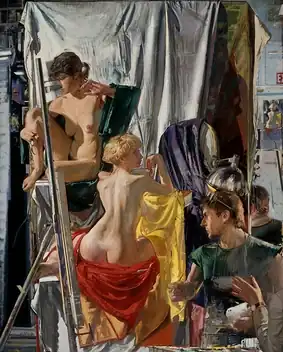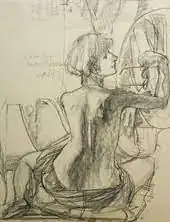| Breaking the Pose | |
|---|---|
| Breaking the Pose (The Art Class) | |
 | |
| Artist | Jerome Witkin |
| Year | 1986 |
| Medium | Oil on canvas |
| Dimensions | 224 cm × 180 cm (7 ft 4 in × 5 ft 11 in) |
| Location | Memorial Art Gallery, Rochester, NY |
Breaking the Pose – alternately titled Breaking the Pose (The Art Class) [1]: Color Plate 18 – is an oil painting from 1986 by the Brooklyn born painter Jerome Witkin . Completed when the artist was 47 and working as a professor at Syracuse university, the work demonstrates why Witkin has been called one of the greatest contemporary artists of his time[2] and one of today’s great narrative painters.[3]
Witkin painted Breaking the Pose in 1986, a tumultuous time in the artist's life. In 1985 the artist was experiencing a period of significant doubt and confusion in his personal life. In 1987 Witkin separated from his 2nd wife after 13 years of marriage.[1]: 86
Witkin uses his paintings as a platform to speak the visual language of the human subconscious and by doing so had inserted himself into the narrative movement of the post-modern art scene. His paintings have a cult following[2] due to the current-ness of his social commentary within his pieces. Witkin has been described as having the skill of old Masters with the current oeuvre of a social realist or an abstract expressionist.[4]
Critics compare Witkins skill, style and psychological thematic content to artists such as Lucien Freud, Manet, Ingres, and Goya.[2]
Description
Breaking the Pose is an oil on canvas painting which stretches 88 by 71 inches,[5] making the human figures depicted nearly life-size. With frenetic and overlapping impasto brushwork, as well as large sections of canvas devoted to wrinkled cloth and other unidentifiable blocks of color there is a strong initial appearance of disorder in the painting. Intentional, thick brushwork, such as the dark heavy line of the artist's easel and the deep, rhythmic shadowing of the backdrop contrast with the backdrops silver and the highly saturated primary colors of the models coverlet.
The three prominent figures within the painting are linearly positioned diagonally with Witkin's self portrait as the in-painting artist at the lower right corner and a brunette nude toward the upper left corner; both of whom help frame the dominant subject of the center of the scene.
The artist is staring intently at the blonde model and the disembodied hand, painted with fierce, energetic brush strokes and is incompletely outlined in red, protrudes from the lower right corner of the canvas, pointing all 5 of its fingers in the models direction. The blonde’s right breast, ribcage and hip are accentuated with a thin stroke of highly saturated red which stands out in contrast to the bright yellow of her coverlet. On her right side the thick streak of blackish-green which runs along the contour of her waist calls attention to the blonde's naturalistic ivory skin tone and the sideways, feminine “v” of her posture. Both brushstroke techniques cause the woman to “pop” out of the canvas.
With her orange strawberry hair, and the candy-apple red and banana-boat yellow of her blankets, she is intensely highlighted by the only warm hues, with very minor exceptions, of the entire painting. The farther away the painting gets from the blonde, central figure, the more monochromatic and lackluster the color becomes. In front of the central figure is a muted blue coverlet and the artist dons a green shirt of low saturation, the exact color of the brunette model's coverlet.
Execution
Witkin claims to be impeded by the use of popular, inexpensive materials of the young and inexperienced artist. He finds that, instead of cotton-duck (a heavy, plain woven cotton fabric) Witkin prefers linen primed with two coats of acrylic gesso. Witkin agrees that there is a reason that “artist”-grade material is more expensive! Witkin has discovered the universal media recipe he concocts before starting any painting. By mixing “six parts gum-turpentine with one part stand-oil and one-and-one-half parts Damar varnish,” Witkin ensures a long lasting matte finish. Linseed oil helps to quicken the drying process.[1]: 83
To add the finishing touch to his work, after the painting has had a month to dry, Witkin will go over it one last time with a mixture made of the same ingredients as he used to begin his painting. A prominent key to Witkin’s process is one that every artist must discover for themselves: how to feel the paint they’re working with and allow the paint to guide the artist.[1]: 83
Witkin is an impulsive, emotional painter. Witkin chooses to draw up preparatory sketches of his figures before applying paint to the canvas as they are how Witkin documents his artistic ideas and his journey of the investigation into his painting,[6]: 3 but claims that too much prep drawing causes frustration. Once he begins painting he prefers using rigger brushes. With this tool he can masterfully manipulate the thickness and intensity of the brushstrokes.[6]: 9–10

While Witkin is spontaneous, he also has a clear, non-negotiable vision he wants to portray. Sometimes he must paint and repaint a figure multiple times in order to get the result he sees in his head. No matter how difficult the subject is to paint, the end result must look effortless to the viewer.[6]: 9–10
Witkin uses photography as a technical influence in his paintings to add a sense of movement and activity. He achieves this technique by blurring forms closer to the edge of the canvas as if a shutter was trying to keep the focal point in focus.[6]: 9–10
Witkin also uses the theater to influence his work and claims each piece is a dramatic collaborative effort between painter and model. Witkin has conversations with his models to discuss how best to capture the intended human experience within each scene.[6]: 9–10
Breaking the Pose is a nearly-life-size painting that captures a snapshot moment of models posing for a painting within a studio setting. Witkin painted himself as the artist within the piece who is painting the models. Witkin used model Lisa Pannella to create Breaking the Pose’s preparatory charcoal sketches.[7]
Influences
Witkin states that he is his own influence. Style and differences between artists or movements doesn’t concern him. Witkin expresses that by trusting in his ability and in the message he wants to convey, that he knows what will work.[6]: 9
Jerome Witkin and his twin brother and fellow artist, photographer Joel-Peter Witkin came together in 2012 to have a joint exhibition of their work called “Twin Visions.” Both brothers have been called some of the greatest contemporary artists in their respective genres. Until the exhibition, the twins had been estranged for decades. Despite the separation, the common theme of psychological pain and cognitive dissonance is evident.
Both artists have a notable fascination with Diego Velazquez Baroque piece Las Meninas and, separately, modeled some of their own work after it.[2]
For Breaking the Pose, Witkin drew from Las Meninas by setting his painting in the studio and capturing multiple subjects, including a prominent self portraiture of himself painting the subjects as if caught candidly, like a photographic snapshot. Like Velasquez, Witkin also adds to his painting a mirror to both extend the scene and add meaning and depth to the piece.[5]
Exhibition
Breaking the Pose by Jerome Witkin was exhibited at the Memorial Art Gallery in 1986[1]: 87 and has been on display in the Hawkes Gallery since the summer of 2019.[5]
References
- 1 2 3 4 5 Chyat, Sherry (1994). Life Lessons. Syracuse, New York: Syracuse University Press. ISBN 0-8156-2617-7.
- 1 2 3 4 "Twin Visions: Jerome Witkin & Joel-Peter Witkin". Jewish Virtual Library.
- ↑ "Jerome Witkin". Jewish Virtual Library.
- ↑ Glueck, Grace (May 12, 2006). "Art in Review; Jerome Witkin". The New York Times – via NYTimes.com.
- 1 2 3 Witkin, Jerome (1986). "Breaking the Pose". Memorial Art Gallery. University of Rochester.
- 1 2 3 4 5 6 Moral Visions: Jerome Witkin. University of Richmond. 1986.
- ↑ Witkin, Jerome (1986). "4th Pose Study: Lisa Pannella Posing-Preparatory Sketch for "Breaking the Pose"". Memorial Art Gallery. University of Rochester.